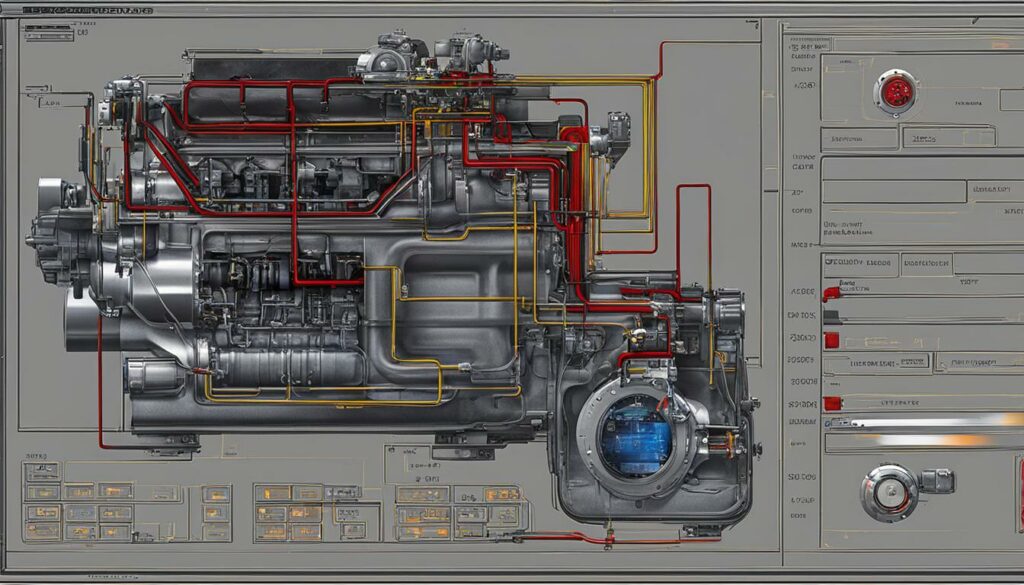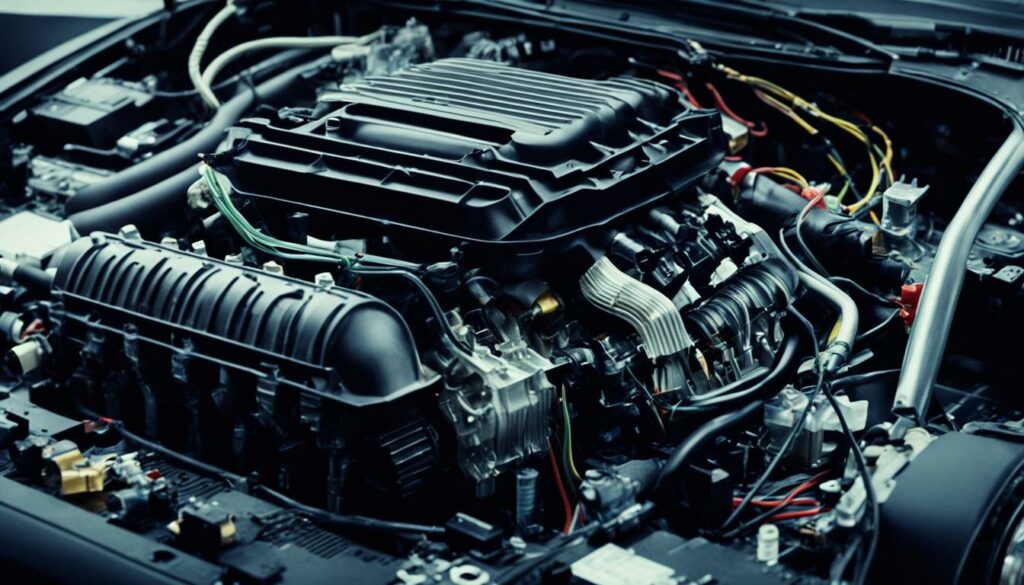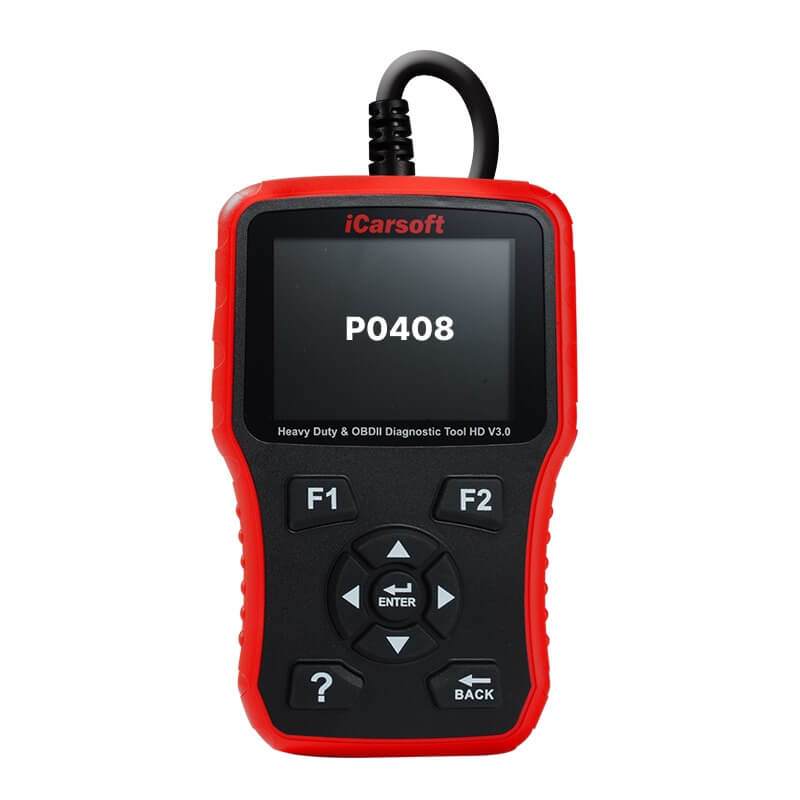P0408 – Exhaust Gas Recirculation Sensor B Circuit High
POSTED IN pcodes
Welcome to our article on the P0408 code, an exhaust gas recirculation (EGR) system-related issue. If you’ve encountered this code in your vehicle’s diagnostic scan, it indicates a problem with the EGR sensor B circuit, specifically a high voltage reading. In this section, we will provide you with a technical description of the code, discuss its severity, symptoms, common causes, troubleshooting steps, and repair options to help you better understand and resolve the issue.
Key Takeaways:
- The P0408 code signifies a fault in the exhaust gas recirculation (EGR) system, specifically the EGR sensor B circuit reporting a high voltage reading.
- Symptoms may include the illumination of the Check Engine Light, engine surging, and intermittent stalls.
- Common causes of the P0408 code include a damaged or defective EGR temperature sensor, wiring issues, carbon buildup, and more.
- To diagnose and repair the P0408 code, a professional mechanic should utilize an OBD-II scanner, perform tests and inspections, and address the underlying cause accordingly.
- If you encounter the P0408 code, it is recommended to seek professional assistance for an accurate diagnosis and efficient repair.
What is the P0408 code?
The P0408 code is a diagnostic trouble code that is stored when the PCM detects an issue with the exhaust gas recirculation (EGR) system. This code specifically indicates a problem with the EGR sensor B circuit, which is reporting a high voltage reading.
The EGR system is responsible for recirculating inert exhaust emissions back into the engine cylinder to reduce nitrogen oxide emissions. When the EGR system is activated, the PCM should detect a certain degree of manifold air pressure change. If it detects a change that is outside the acceptable range, it will record the P0408 code. The code is typically stored after one or more instances of the out-of-range voltage reading.

According to diagnostic standards, the code’s meaning, definition, and explanation can be summarized as follows:
Buy tested tuning file for Adblue / EGR / DPF / Adblue off now!
| Code | Meaning | Definition | Explanation |
|---|---|---|---|
| P0408 | EGR Sensor B Circuit High | The EGR sensor B circuit is reporting a high voltage reading | Indicates a problem with the EGR sensor B circuit, possibly caused by issues with the sensor or circuit itself |
Symptoms of the P0408 Code
When your vehicle’s onboard diagnostic system detects the P0408 code, it can exhibit several symptoms that indicate an issue with the exhaust gas recirculation (EGR) system. Familiarizing yourself with these symptoms can help you identify the problem and seek timely repairs. The following are the common signs of the P0408 code:
- Check Engine Light (CEL) Illumination: The most noticeable symptom of the P0408 code is the illumination of the Check Engine Light on your vehicle’s dashboard. This warning light is designed to alert you to potential problems with your vehicle’s systems, including the EGR system.
- Engine Surging: Another symptom you may experience is engine surging during operation. Engine surging refers to a fluctuation in the engine’s RPM (revolution per minute), causing the vehicle to accelerate or decelerate unexpectedly. This irregular surging can affect your driving experience and overall vehicle performance.
- Intermittent Engine Stalls: In some cases, the P0408 code can lead to intermittent engine stalls. The engine may shut off unexpectedly while you are driving or idling, posing a safety risk and causing inconvenience. If you notice your engine stalling frequently, it is crucial to address the underlying problem promptly.
It’s important to note that some drivers may not notice any discernible change in the vehicle’s performance, apart from the illuminated Check Engine Light. However, even without noticeable symptoms, it is crucial to address the P0408 code and repair the EGR system as soon as possible.
Additionally, it’s worth mentioning that an increase in nitrogen oxide emissions may occur due to the elevated combustion temperature caused by the P0408 code. While this increase is usually undetectable to the driver, it can potentially impact the environment. Therefore, it is essential to address the P0408 code promptly to ensure the proper functioning of the EGR system and reduce harmful emissions.

Causes of the P0408 code
The P0408 code can be triggered by several potential causes. These include:
- 1. Damaged or defective EGR temperature sensor: A malfunctioning EGR temperature sensor can fail to provide accurate readings, leading to the detection of the P0408 code.
- 2. Fault in the EGR temperature sensor’s circuit: Issues with the circuitry connected to the EGR temperature sensor can disrupt the sensor’s functionality and trigger the P0408 code.
- 3. Shorted or open connection in the EGR volume control solenoid valve circuit: Problems with the circuitry of the EGR volume control solenoid valve can cause irregular voltage readings, resulting in the P0408 code.
- 4. Excessive carbon buildup on the EGR valve: Carbon deposits on the EGR valve can impede its proper functioning, leading to the detection of the P0408 code.
- 5. Damaged or defective EGR volume control solenoid valve: A faulty EGR volume control solenoid valve can disrupt the EGR system’s operation, resulting in the P0408 code.
- 6. Open ground circuit for the EGR sensor: An open ground circuit in the EGR sensor can cause irregular voltage readings and trigger the P0408 code.
- 7. Internal failure in the solenoid or EGR sensor: Internal damage or malfunction within the solenoid or EGR sensor can affect their performance and result in the detection of the P0408 code.
These issues can affect the proper functioning of the EGR system and lead to the detection of the P0408 code.
Diagnosing and repairing the P0408 code
To effectively diagnose and repair the P0408 code, a mechanic will follow a systematic approach using specialized tools and techniques. By following these diagnostic steps, the exact cause of the code can be identified, allowing for proper repairs to be performed. Here’s an overview of the diagnostic and repair process for the P0408 code:
- OBD-II Scanner: The mechanic will begin by connecting an OBD-II scanner to the vehicle’s diagnostic port. This scanner will retrieve the P0408 code and any other related codes stored in the PCM.
- Visual Inspection: The mechanic will visually inspect the EGR system components, looking for any obvious signs of damage, loose connections, or excessive carbon buildup. This inspection will help identify any potential issues that may be causing the P0408 code.
- EGR Valve Cleaning: If carbon buildup is detected on the EGR valve, the mechanic may attempt to clean it using an appropriate cleaner. This can help restore proper valve operation and resolve the P0408 code.
- Functional Testing: The mechanic will test the functionality of the EGR valve, EGR temperature sensor, and related components using specialized diagnostic equipment. This will help determine if any of these components are faulty and need to be replaced.
- Circuit Inspection: The mechanic will inspect the wiring, circuits, and connections associated with the EGR sensor and solenoid. This will help identify any wiring faults or open/short circuits that may be causing the P0408 code.
- EGR Temperature Sensor Replacement: If the EGR temperature sensor is found to be faulty, the mechanic will replace it with a new sensor. This will ensure accurate temperature readings and proper EGR system operation.
- Circuit Repair: If any circuit or connection issues are identified, the mechanic will perform the necessary repairs to restore proper electrical function. This may involve repairing damaged wires, replacing connectors, or addressing other circuit-related issues.
- EGR Valve Replacement: If the EGR valve itself is found to be faulty, the mechanic will replace it with a new valve. This will ensure proper gas flow and prevent further issues with the EGR system.
- EGR Volume Control Solenoid Valve Replacement: If the EGR volume control solenoid valve is determined to be the cause of the P0408 code, the mechanic will replace it. This will restore proper control over the EGR system and rectify the code.
Following these diagnostic and repair steps should resolve the P0408 code and allow for optimal EGR system function. It is advised to seek the assistance of a professional mechanic for an accurate diagnosis and efficient repair of the P0408 code.
Conclusion
In conclusion, the P0408 code is a diagnostic trouble code that indicates a problem with the exhaust gas recirculation (EGR) system, specifically the EGR sensor B circuit reporting a high voltage reading. This code can cause various symptoms, such as the illumination of the Check Engine Light, engine surging, and intermittent stalls, which can affect the overall performance of your vehicle.
The P0408 code can be triggered by different underlying causes, including a faulty EGR temperature sensor, issues with the EGR circuit or connection, carbon buildup on the EGR valve, or failure of the EGR volume control solenoid valve. Proper diagnosis of the code involves using an OBD-II scanner to retrieve the code and performing tests and inspections to identify the specific cause.
Once the cause of the P0408 code is determined, it is important to seek professional assistance to ensure an accurate diagnosis and efficient repair. This may involve replacing the EGR temperature sensor, repairing any circuit or connection issues, cleaning or replacing the EGR valve, or replacing the EGR volume control solenoid valve. Professional expertise will ensure that the issue is addressed correctly, preventing further damage and restoring the proper functioning of your vehicle.
FAQ
What does the P0408 code mean?
The P0408 code indicates a problem with the exhaust gas recirculation (EGR) system. Specifically, it refers to the EGR sensor B circuit reporting a high voltage reading.
What are the symptoms of the P0408 code?
The symptoms of the P0408 code may include the illumination of the Check Engine Light, engine surging during operation, and intermittent engine stalls.
What are the common causes of the P0408 code?
The P0408 code can be triggered by several potential causes, including a damaged or defective EGR temperature sensor, a fault in the EGR temperature sensor’s circuit, a shorted or open connection in the EGR volume control solenoid valve circuit, excessive carbon buildup on the EGR valve, a damaged or defective EGR volume control solenoid valve, an open ground circuit for the EGR sensor, or an internal failure in the solenoid or EGR sensor.
How is the P0408 code diagnosed and repaired?
To diagnose the P0408 code, a mechanic will typically use an OBD-II scanner to identify the code and any other stored codes. They may also perform additional tests and inspections to pinpoint the exact cause of the code. Repairs for the P0408 code can include replacing the EGR temperature sensor, repairing any circuit or connection issues, cleaning or replacing the EGR valve, or replacing the EGR volume control solenoid valve.


